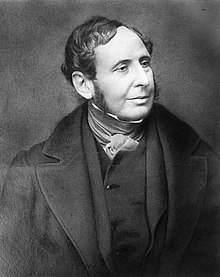Robert Fitz Roy
|
Vice-Admiral Robert FitzRoy RN |
|
|---|---|

Robert FitzRoy
|
|
| 2nd Governor of New Zealand | |
|
In office 26 December 1843 – 18 November 1845 |
|
| Monarch | Victoria |
| Preceded by | Captain William Hobson |
| Succeeded by | Sir George Grey |
| Personal details | |
| Born |
5 July 1805 Ampton, Suffolk, England, United Kingdom of Great Britain and Ireland |
| Died | 30 April 1865 (aged 59) Upper Norwood, England |
| Cause of death | Suicide |
| Nationality | English |
| Spouse(s) |
|
| Children | 5 |
Vice-Admiral Robert FitzRoy RN (5 July 1805 – 30 April 1865) was an English officer of the Royal Navy and a scientist. He achieved lasting fame as the captain of HMS Beagle during Charles Darwin's famous voyage, FitzRoy's second expedition to Tierra del Fuego and the Southern Cone.
FitzRoy was a pioneering meteorologist who made accurate daily weather predictions, which he called by a new name of his own invention: "forecasts". In 1854 he established what would later be called the Met Office, and created systems to get weather information to sailors and fishermen for their safety. He was an able surveyor and hydrographer. As Governor of New Zealand, serving from 1843 to 1845, he tried to protect the Māori from illegal land sales claimed by British settlers.
Robert FitzRoy was born at Ampton Hall, Ampton, Suffolk, England, into the upper echelons of the British and a tradition of public service. Through his father, General Lord Charles FitzRoy, Robert was a fourth great-grandson of Charles II of England; his paternal grandfather was Augustus Henry FitzRoy, 3rd Duke of Grafton. His mother, Lady Frances Stewart, was the daughter of the first Marquess of Londonderry and the half-sister of Viscount Castlereagh, who became Foreign Secretary. From the age of four, Robert FitzRoy lived with his family at Wakefield Lodge, their Palladian mansion in Northamptonshire.
...
Wikipedia
